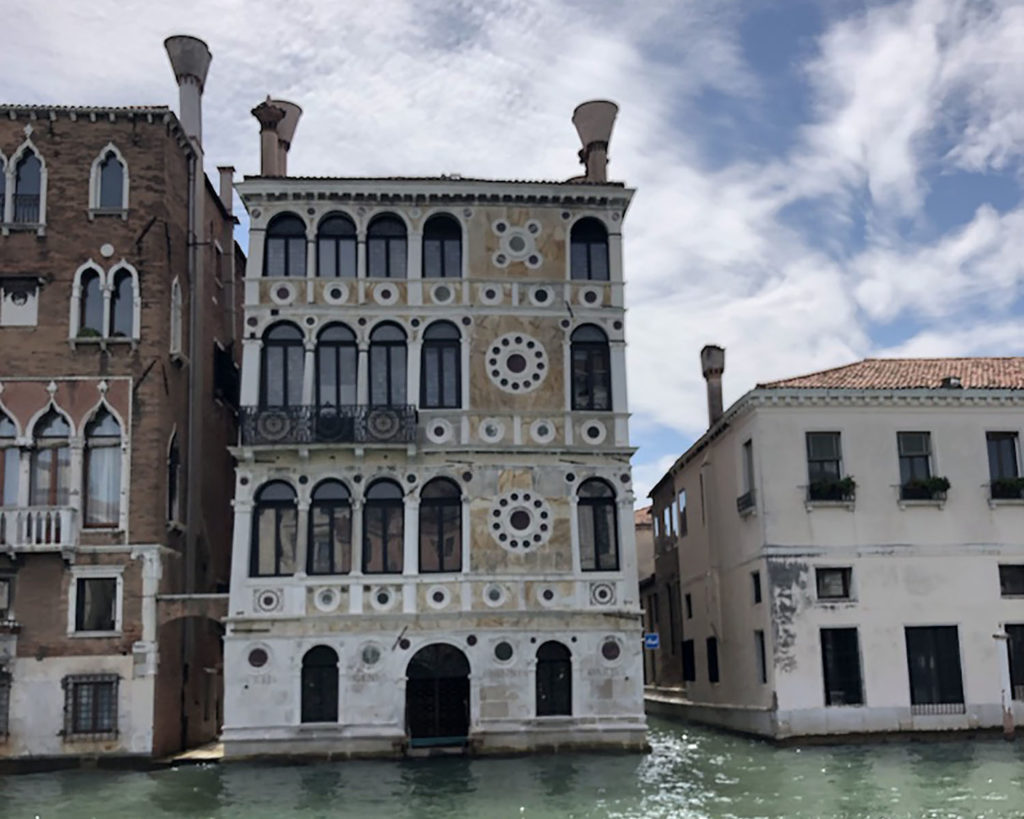Palazzo Dario is one of the most famous early renaissance palaces in Venice and was erected at the end of the 15th century by Giovanni Dario, secretary of the Venetian senate.
Overlooking the Grand Canal, the building has a slender and asymmetrical facade with a width limited to about 10 meters. It presents Renaissance elements, in contrast with the other facades inspired by the Gothic style still widespread at the time. The chimneys, in typical Venetian style, are among the very few original specimens that have survived to this day without particular restructuring. The interiors are “fairytale”: there is a large atrium with a marble well, a finely decorated marble staircase that leads to the noble floors and an oriental-inspired internal fountain, placed in a room that reflects the Moorish style in the decoration and shape of the windows. The rear façade is plastered red and overlooks Campiello Barbaro from where it is possible to admire the complex of chimneys, turrets, Gothic windows and loggias.
His strange beauty struck the interest of John Ruskin, who described the marble decorations in great detail. In 1908 Claude Monet used Ca ‘Dario as a subject for a series of impressionist paintings: all from the same perspective, but with different lighting conditions.
According to legend the house is cursed: whoever lives here is destined for bankruptcy or committed suicide. After the death of Giovanni Dario the building passed in 1494 to his daughter Marietta who was married to the rich Giacomo Barbaro: the man suffered a financial collapse and died stabbed. The woman, after this crisis, committed suicide. Tragic end also for their son Giacomo, who died in an ambush. The Barbaro family kept the building until the 19th century.
Later, the owners changed frequently. The British historical scholar Rawdon Brown died mysteriously with his companion. The palace later housed the French poet Henri de Régnier, until a serious illness interrupted his Venetian stays.
After the war Ca ‘Dario was bought by the American billionaire Charles Briggs who was forced to leave Venice because of rumors about his homosexuality and shortly after he was struck by a serious loss: the death by suicide of his lover.
Until 1964 Ca ‘Dario remained without an owner. Among the possible buyers came the tenor Mario Del Monaco, who however broke the talks because he was the victim of a serious car accident that forced him to interrupt his career.
A few years later the palace was bought by the Turin count Filippo Giordano delle Lanze, who was killed in 1970 inside the palace by his lover Raul Blasich, who was also stabbed to death in London.
The building was later purchased by Christopher “Kit” Lambert, manager of the rock band The Who, who fell in love with his romantic and melancholic appearance. He suffered a financial collapse and three years after the building was sold in 1978, he committed suicide. Lambert sold the palace to Fabrizio Ferrari, who went bankrupt as well a few years later.
At the end of the eighties the palace was bought by the Italian businessman Raul Gardini, to give it to his daughter. He was soon involved in numerous financial scandals and suffered heavy losses. He also died by a suicide in his home in Milan in 1993.
After the death of Gardini nobody wanted to buy the Ca ‘Dario palace anymore. In 2002, a week after renting Ca ‘Dario for a vacation in Venice John Entwistle, bass player for The Who, died of a heart attack in Las Vegas.
Since 2006 the building has been owned by an American company representing an unknown buyer and is currently being restored.
There are many legends and mysteries about Ca ‘Dario, some say that it was built on a temple cemetery, others that it is due to a strong amulet from a nearby building. Even if we don’t know the true story, seeing the palace we can admire its cursed beauty.
Location: Ca’ Dario Palace, Venice






